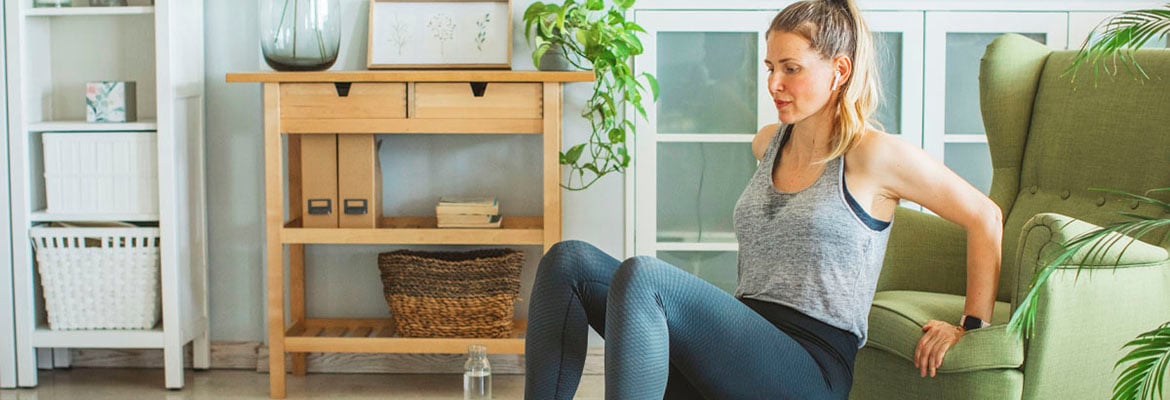
It’s commonly known that exercise can be highly beneficial for both your physical and mental health.
Exercise can help you reduce your risk of developing chronic conditions. Some of these include type 2 diabetes, heart disease, many types of cancer, depression, anxiety and dementia.1 You can decrease your risk of dying prematurely from any cause by 30 percent and decrease your risk of dying from heart disease by 50 percent if you are physically fit.1, 2
The World Health Organization has identified physical inactivity as one of the most important modifiable risk factors to reduce the incidence of chronic disease. Despite the harms of physical inactivity, only 16 per cent of Canadian adults meet the Canadian physical activity guideline of 150 minutes of moderate to vigorous physical activity per week.3 Only 40 percent of Canadian children and youth aged five to 17 meet their physical activity target of 60 minutes per day.3
Sometimes it can be hard to establish a new exercise routine, especially if you haven’t had one in the past. A Preventive Health Assessment at TELUS Health Care Centres can help you understand your current fitness levels, and working with a dedicated multidisciplinary health team can help create a realistic exercise routine based on your unique needs and goals.
We caught up with Jamie McKenzie, registered kinesiologist at TELUS Health Care Centres, to learn more about how to get started when it comes to exercising.
How to get started with a new exercise routine
According to McKenzie, the most effective way to begin an exercise routine that will last is to start small.
“Consistency is more important than quantity, especially at the beginning,” he says. “If you start out too hard right out of the gate, you’re more likely not to continue. A lot people go really hard with their workout on the first day and then feel very sore afterward. This can create a mental barrier, where you come to associate exercise with a lot of soreness and effort.
It’s much better, McKenzie shares, to start small and gradually increase your exercise.
Another important tip he shared: focus on making exercise a lifestyle change, as opposed to trying to track results and outcomes right away. Achieving results takes time. We are often all too accustomed to instant gratification when it comes to tech or other areas of our lives. But when it comes to physical results of exercise, McKenzie reminds us that patience (and consistency) are key.
What are some 'go-to' exercises that beginners can try?
We asked McKenzie for some ideas for exercise for someone who is establishing a fitness routine for the first time. His advice is to start with an activity that you enjoy.
“You’ll be more likely to continue with something that you like,” he says. “If you aren’t sure what to choose, a 10 minute walk can be a great place to begin. From there, you can start incorporating strength training. This might include bodyweight exercises, resistance bands, or light weights.”
He also notes that this is where the guidance of an exercise expert can be really beneficial. They can help you figure out what combination of exercises works best for you and your body, as well as how to make the most of the time you spend exercising so that you are being as efficient as possible.
Part of a Preventive Health Assessment at TELUS Health Care Centres involves a movement assessment. This, McKenzie notes, allows a kinesiologist to see if there is any movement dysfunction in your body.
“From there, we can help by providing exercises that improve mobility and navigate around or through any previous injury,” he says. “We can also provide guidance around goal setting, including what some realistic goals may look like, along with timelines and expectations for results.”
What a registered kinesiologist wants you to know
We asked McKenzie what the most important thing was to remember for people embarking on an exercise routine for the first time.
“You have to prioritize mobility first,” he emphasized. “There should be a baseline of mobility before an exercise routine can be effectively established.”
This means that you should be able to move your joints through their full range of motion before upping the intensity of physical activity.
Get a fitness plan that's right for you
A Preventive Health Assessment at TELUS Health Care Centres can help you establish an exercise routine that works best for your lifestyle, your body and your personal goals. With a dedicated team of physicians, kinesiologists, dietitians and other health care professionals, find out more about how you can optimize your current health and your physical fitness.
Written in consultation with Jamie McKenzie, registered kinesiologist.
References
1 Radcliffe, S. 2020. “Staying Physically Active May Lower Your Risk of Death by 30%” Healthline.com
2 European Society of Cardiology. 2016. “Moderate physical activity linked with 50 percent reduction in cardiovascular death in over-65s: The cardiovascular risks of modern life.” ScienceDaily.
3 Statistics Canada. 2019. “Tracking physical activity levels of Canadians, 2016 and 2017.” www150.statcan.gc.ca
